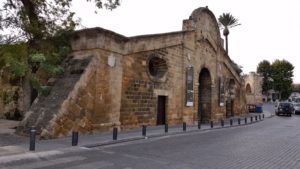Revisiting Archive In the Aftermath of Revolution was the title of the symposium on hosted by the Haus der Kulturen der Welt (HKW) in Berlin on October 26-28, organized by the Arab Fund for Arts and Culture (AFAC) in association with the research program Europe in the Middle East – the Middle East in Europe (EUME).
The symposium brought together historians, archivists, artists, collectors and story-tellers to address the question of the archive after the revolution and also pertinently, during ongoing oppression and destruction. There were presentations on ongoing projects, film screenings, performances, and discussions. While presenters refrained from repeating old scholarly dilemmas in working with archives and memory practices, the diversity of the projects was one thing that gave me hope and courage despite the fact that the peril is high for working toward an archive in most of the corners of the MENA.
Symposium started with the keynote lecture by the Egyptian historian Khaled Fahmy who shared the story of his experience with the official committee that was established to document the January 25th revolution in Egypt. The committee actually was commissioned officially and had the mission to create an open archive to be housed at the National Archive, collecting newspaper stories, editorials, reports from human rights organizations and religious groups, photographs, slogans, and songs, as well as testimonies. After about a year-long work by the committee members and their subcommittees, the effort collapsed when General Sisi came to power and the National Archive proved to be a state-within-state, as we say in Turkey. Fahmy describes the ideal mission of the committee as “bringing Tahrir to archives, and bringing archives to Tahrir”, as the duality of the task: not only to document and amass, but also to change the (national) archive itself and turn it into an open research institution where people have access to documents and can write their own history.
One thing I have learned during my doctoral study at the Photographic Dispositif program from our visits to numerous institutions and their archives is that each archive is a different animal: the character and function of the archive depend on the material that is collected but also on the function it was aimed to fulfill, and sometimes simply on the character of its founder (work discipline, values, priorities, and the archiving methodology s/he developed, etc.). At the symposium, presenters also revealed a diversity of problematics related to the materials they work with or the archives they hope to achieve. The imaginary archives connects the past and present possibility (of the material), with their tentacles extending to the future, of a storytelling.

One impressive effort in creating an archive in the aftermath of revolution is devoted to the creative memory of the Syrian Revolution. Films, grafitti, photographs, songs, all kinds of documents are being collected at the Creative Memory website which is available in three languages, Arabic, English and French. The documents are also stored and displayed in three languages, in which each translation is considered as a document. Those who work in this project continue to work on the documents in order to reach more details about their creator or their first origin, a daunting task considering the ephemerality and fragility of posts and links. The database is presented in 22 categories and it is also possible to search the archive through geographical tags.
This archive speaks to my own project so loudly that I feel the need to attend to that conversation for at least a couple of days.
